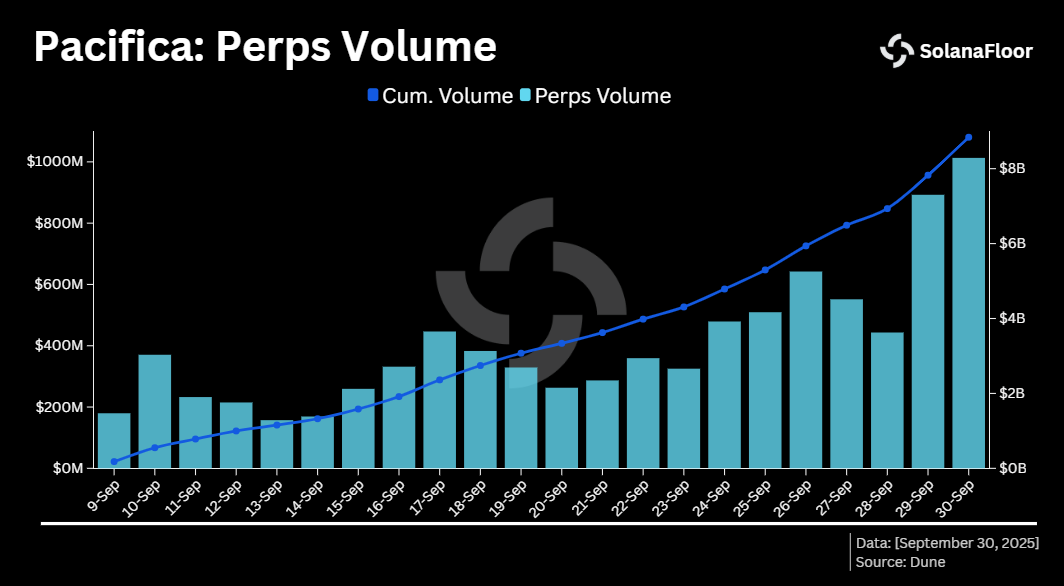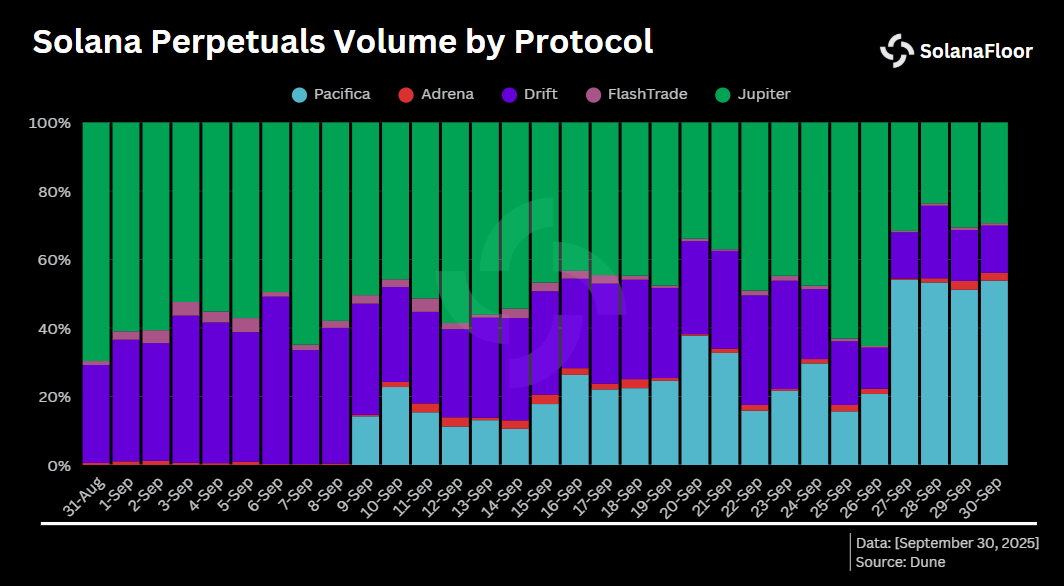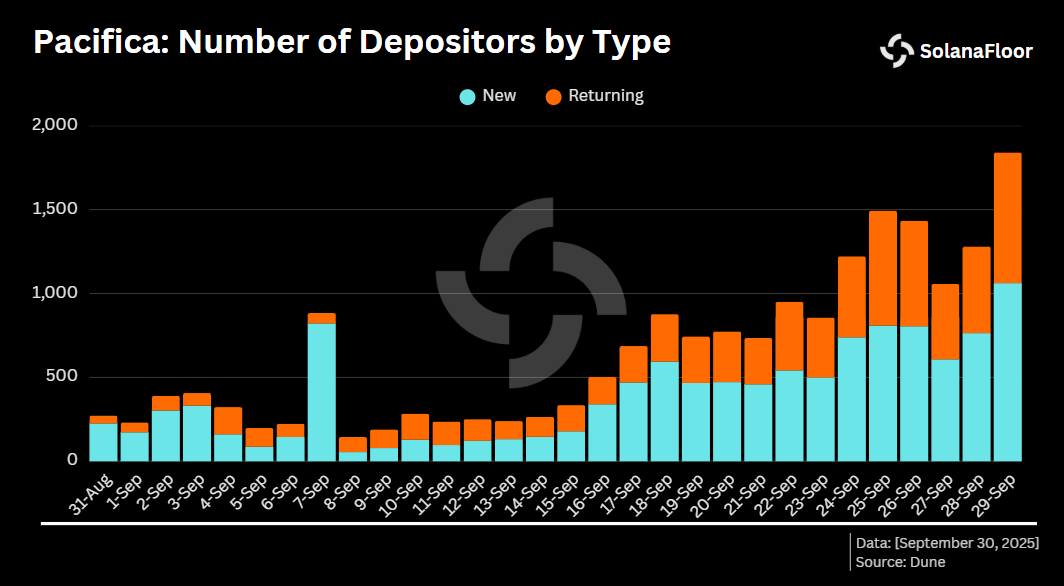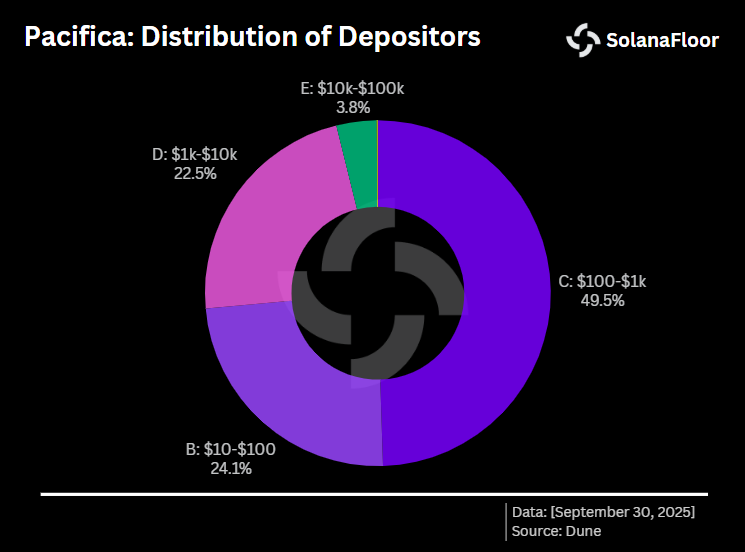
パシフィカ、ソラナでの取引活動が加速し、1日の犯罪取引高が10億ドルに到達
料金引き下げとエアドロップの思惑が急速な普及に拍車をかけるが、持続可能性には疑問が残る
- 公開:
- 編集済み:
Pacificaは、Solana上の新しい永久取引プロトコルであり、まだプライベートベータ版であり、招待によってのみアクセス可能である。この初期段階にもかかわらず、ここ数週間、プラットフォーム上のアクティビティが急増し、注目を集めている。より透明性を高めるためのデータについて話そう。
9月の取引量増加
 デューンのデータによると、9月9日以来、パシフィカでの累積取引量は88.3億ドルを超えています。1日の取引量は、9月9日の2億ドル以下から9月30日には10億ドル以上になり、3週間足らずで5倍になった。
デューンのデータによると、9月9日以来、パシフィカでの累積取引量は88.3億ドルを超えています。1日の取引量は、9月9日の2億ドル以下から9月30日には10億ドル以上になり、3週間足らずで5倍になった。
取引手数料を一時的に半額にするというプロトコルの選択が、この成長の明らかな原動力となっている。
取引手数料を一時的に半額にするというプロトコルの選択は、この成長の明らかな原動力となっている。
パシフィカでの取引活動は大型資産に集中している。BTCの不正取引は過去24時間で$644Mを占め、$ETHが$244Mで続いた。SOLのperpsは$43.7Mに達し、このネットワークのネイティブトークンは$BTCと$ETHの後塵を拝しています。
Solana’のパーピングマーケットシェアの変化
 取引量が増加した結果、Solana Perp取引におけるPacifica’のシェアは9月27日までに54%に上昇した。同時に、ジュピターは30%を下回り、ドリフトは14%を下回った。しかし、パシフィカが料金水準が正常化した後、このポジションを維持できるかどうかを判断するのはまだ早い。
取引量が増加した結果、Solana Perp取引におけるPacifica’のシェアは9月27日までに54%に上昇した。同時に、ジュピターは30%を下回り、ドリフトは14%を下回った。しかし、パシフィカが料金水準が正常化した後、このポジションを維持できるかどうかを判断するのはまだ早い。
持続可能性への関心と懸念
 1日の取引高は10億ドルの大台を超えたが、パシフィカの建玉(OI)は6,880万ドルと比較的小幅にとどまっている。取引量の多さとOIの低さのギャップは、活動の深さと粘り強さについて疑問を投げかけるものだ。
1日の取引高は10億ドルの大台を超えたが、パシフィカの建玉(OI)は6,880万ドルと比較的小幅にとどまっている。取引量の多さとOIの低さのギャップは、活動の深さと粘り強さについて疑問を投げかけるものだ。
現在のOI分布は、$29.1Mの$BTCを筆頭に、$16.9Mの$ETH、$580Mの$SOLが続く。これらの数字は実際の取引を示しているが、ポジションが長く保有されていないことを示唆している。
入金額とユーザーベースの拡大
 参加するために、トレーダーは$USDCをパシフィカに入金する。純預入額は2,300万ドルで、9月26日(240万ドル)と9月29日(190万ドル)が流入のピークだった。2回目の急増は手数料引き下げの発表と一致した。
参加するために、トレーダーは$USDCをパシフィカに入金する。純預入額は2,300万ドルで、9月26日(240万ドル)と9月29日(190万ドル)が流入のピークだった。2回目の急増は手数料引き下げの発表と一致した。
 入金アドレス数は9月中旬の約260から9月29日には1,800以上に拡大した。57%以上が新しいアドレスである。合計で14.2万ウォレットが入金しており、その63%は9月15日以降に入金したものです。
入金アドレス数は9月中旬の約260から9月29日には1,800以上に拡大した。57%以上が新しいアドレスである。合計で14.2万ウォレットが入金しており、その63%は9月15日以降に入金したものです。
 デポジットサイズの分析では、リテールの参加が強いことが指摘されています。全ウォレットの半数近くが100ドルから1000ドルの間に入金している。さらに24.1%は10ドルから100ドルの間で入金し、22.5%は1000ドルから10,000ドルの範囲で入金している。1万ドル以上10万ドル未満のウォレットはわずか3.8%だった。
デポジットサイズの分析では、リテールの参加が強いことが指摘されています。全ウォレットの半数近くが100ドルから1000ドルの間に入金している。さらに24.1%は10ドルから100ドルの間で入金し、22.5%は1000ドルから10,000ドルの範囲で入金している。1万ドル以上10万ドル未満のウォレットはわずか3.8%だった。
このパターンは、パシフィカのユーザー増加が主に小規模トレーダーによってもたらされていることを示しています。
展望
パシフィカが急速に台頭してきたことで、ソラーナのパープに対する注目度が変わってきた。また、「パシフィカ」は、「パシフィカ」と「パシフィカ」の2つのブランドで構成されており、「パシフィカ」は、「パシフィカ」、「パシフィカ」、「パシフィカ」、「パシフィカ」、「パシフィカ」、「パシフィカ」の4つのブランドで構成されています。
パシフィカが短期的な成長を持続的な市場シェアにつなげられるかどうかは、インセンティブが緩和された後、より深い流動性を引きつけ、ユーザーを維持できるかどうかにかかっている。
パシフィカが短期的な成長を永続的な市場シェアにつなげられるかどうかは、より深い流動性を集め、インセンティブが緩和された後にユーザーを維持できるかどうかにかかっている。
ソラナフロアについてもっと読む
ソラナのUSD1:最初の月に1億7500万供給と12億ドルの取引量
DATとETFは2026年までにSOLが500ドルを達成するのに役立つか?



